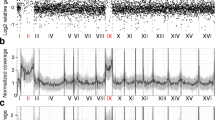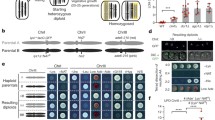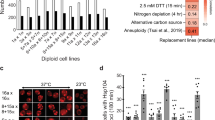Abstract
Heterokaryotic zygotes in yeast provide a unique possibility to study the survival and transmission of two genetically diverse nuclei in one cell. Using partial pedigree analysis, we show that various treatments used to change cytoplasmic hereditary determinants can essentially affect nuclear transmission in yeast heterokaryons. This includes choice of nucleus to enter the first bud and incidence of various classes of mother/daughter pairs demonstrating nuclear degradation patterns in heterokaryotic zygotes. These treatments include guanidine hydrochloride, a prion-curing agent, ethidium bromide, an agent causing elimination of mitochondrial DNA, and cytoplasm replacement by cytoduction, which leads to mtDNA replacement and transfer of some other cytoplasmically inherited determinants. The genetic and cytological evidence obtained favors prion involvement in nuclear transmission and suggests apoptotic features in nuclear degradation in yeast heterokaryotic zygotes.



Similar content being viewed by others
References
Borchsenius AS, Tchourikova AA, Inge-Vechtomov SG (2000) Recessive mutations in SUP35 and SUP45 genes coding for translation release factors affect chromosome stability in Saccharomyces cerevisiae. Curr Genet 37:285–291
Chasinska A, Szczesniak B, Kochneva-Pervukhova NV, Kushnirov VV, Ter-Avanesyan MD, Boguta M (2001) Ssb1 chaperone is a [PSI+] prion-curing factor. Curr Genet 39:62–67
Chernoff YO (2001) Mutation processes at the protein level: is Lamarck back? Mutat Res 488:39–64
Chernoff YO, Uptain SM, Lindquist SL (2002) Analysis of prion factors in yeast. Methods Enzymol 351:499–538
Conde J, Fink GR (1976) A mutant of Saccharomyces cerevisiae defective for nuclear fusion. Proc Natl Acad Sci USA 73:3651–3655
Cox BS, Tuite MF, McLaughlin CS (1988) The psi-factor of yeast: a problem in inheritance. Yeast 4:159–178
Derkatch IL, Bradley ME, Masse SVL, Zadorsky SP, Polozkov GV, Inge-Vechtomov SG, Liebman SW (2000) Dependence and independence of [PSI+] and [PIN+]: a two-prion system in yeast? EMBO J 19:1942–1952
Dujon B (1981) Mitochondrial genetics and functions. In: Strathern JM, Jones EW, Broach JR (eds) Molecular biology of the yeast Saccharomyces. Cold Spring Harbor Laboratory, Cold Spring Harbor, N.Y., pp 505–635
Froechlich K-U, Madeo F (2001) Apoptosis in yeast: a new model for aging research (mini-review). Exp Gerontol 37:27–31
Glass NL, Kaneko I (2003) Fatal attraction: nonself recognition and heterokaryon incompatibility in filamentous fungi (mini-review). Eukaryot Cell 2:1–8
Helfant AH (2002) Composition of the spindle body of Saccharomyces cerevisiae and the proteins involved in its duplication. Curr Genet 40:291–301
Lancashire WE, Mattoon JR (1979) Cytoduction: a tool for mitochondrial genetic studies in yeast. Mol Gen Genet 170:333–344
Ludovico P, Rodrigues F, Almeida A, Silva MT, Barrientos A, Corte-Real M (2002) Cytochrome c release and mitochondria involvement in programmed cell death induced by acetic acid in Saccharomyces cerevisiae. Mol Biol Cell 13:2598–2606
Maddelein ML, Dos Reis S, Duvezin-Caubet S, Coulary-Salin B, Saupe SJ (2002) Amyloid aggregates of the HET-s prion aggregates are infectious. Proc Natl Acad Sci USA 99:7402–7407
Madeo F, Froechlich E, Froechlich K-U (1997) A yeast mutant showing diagnostic markers of early and late apoptosis. J Cell Biol 139:729–734
Madeo F, Froechlich E, Ligr M, Grey M, Sigrist SJ, Wolf DH, Froechlich K-U (1999) Oxygen stress: a regulator of apoptosis in yeast. J Cell Biol 145:757–767
Madeo F, Engelhardt S, Hecker E, Lehmann N, Maldener C, Proksch H, Wissing S, Froechlich K-U (2002) Apoptosis in yeast: a new model system with applications in cell biology and medicine. Curr Genet 41:208–216
Nevzglyadova OV, Artyomov AV, Gaivoronski AA, Soidla TR (2002) Concealed nuclei in Saccharomyces strains (mini-review). FEMS Yeast Res 2:471–479
Pavlov E, Priault M, Pietkiewitz D, Cheng EH, Antonsson B, Manon S, Korsmeyer SJ, Mannella CA, Kinnally KW (2001) A novel, high conductance channel of mitochondria linked to apoptosis in mammalian cells and Bax expression in yeast. J Cell Biol 155:725–731
Pinan-Lucarre B, Paoletti M, Dementhon K, Coulary-Salin B, Clave C (2003) Autophagy is induced during cell death by incompatibility and is essential for differentiation in the filamentous fungus Podospora anserina. Mol Microbiol 47:321–333
Sachs L (1972) Statistische Auswertungsmethoden. Springer, Berlin Heidelberg New York
Sherman F, Fink GR, Hicks JB (1986) Laboratory course manual for methods in yeast genetics. Cold Spring Harbor Laboratory, Cold Spring Harbor, N.Y.
Tikhomirova VN, Inge-Vechtomov SG (1996) Sensitivity of sup35 and sup45 mutants in Saccharomyces cerevisiae to the antimicrotubule drug benomyl. Curr Genet 30:44–49
True HL, Lindquist SL (2000) A yeast prion provides a mechanism for genetic variation and phenotypic diversity. Nature 407:477–483
Wegrzyn RD, Bapat K, Newnam GP, Zink AD, Chernoff YO (2001) Mechanism of prion loss after Hsp104 inactivation in yeast. Mol Cell Biol 21:4656–4669
Yamaki M, Umehara T, Chimura T, Horikoshi M (2001) Cell death with predominant apoptotic features in Saccharomyces cerevisiae mediated by deletion of the histone chaperone Asf1/CIA1. Genes Cells 6:1043–1054
Zakharov IA, Yarovoy PP (1977) Cytoduction as a new tool in studying the cytoplasmic heredity in yeast. Mol Cell Biochem 14:15–18
Acknowledgement
This work was supported by a grant from the St Petersburg Scientific Center of the Russian Academy of Sciences.
Author information
Authors and Affiliations
Corresponding author
Additional information
Communicated by S. Hohmann
Rights and permissions
About this article
Cite this article
Nevzglyadova, O.V., Artyomov, A.V., Mikhailova, E.V. et al. The impact of manipulations with cytoplasmically inherited factors on nuclear transmission and degradation in yeast heterokaryons. Curr Genet 45, 273–282 (2004). https://doi.org/10.1007/s00294-004-0493-9
Received:
Revised:
Accepted:
Published:
Issue Date:
DOI: https://doi.org/10.1007/s00294-004-0493-9




